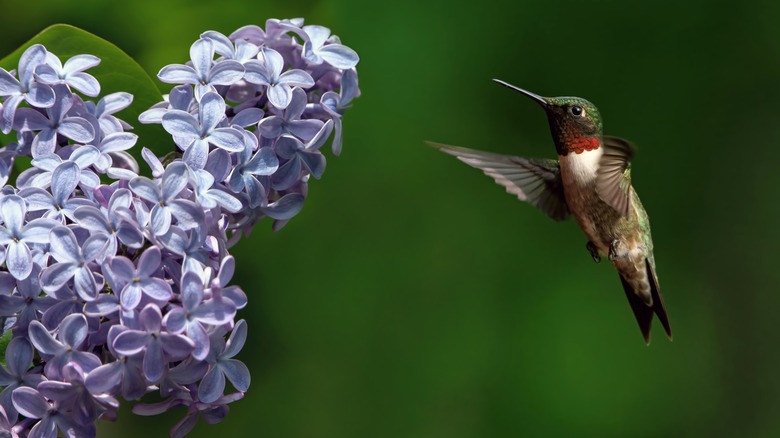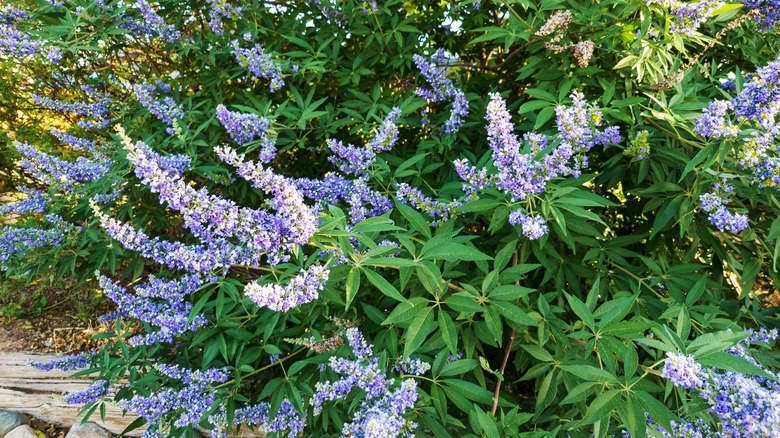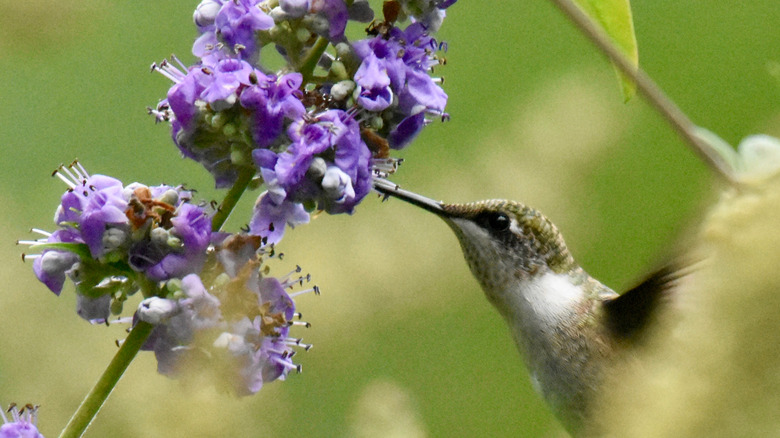The Pretty Lilac Alternative That Hummingbirds Love (& If It's Right For Your Yard)
If you love lilacs but don't have a lot of time for plant care, the lovely purple plant has a low-maintenance twin, the chaste tree (Vitex agnus-castus). This leafy small tree or shrub resembles lilacs but requires much less attention. It's a beautiful plant that takes its name from an ancient folk remedy that claimed the berries calmed monks' sexual urges. It goes by other monikers like chasteberry, monk's pepper, and lilac chaste tree.
The chaste tree's cone-shaped purplish-blue blooms are like a neon sign advertising nectar to hummingbirds and insects alike. While its scent doesn't match lilac's evocative fragrance, pollinators don't mind the difference. Hummingbirds go crazy for the chaste tree's nectar.
With its fast growth, it can reach heights and widths of up to 20 feet, so most types of chaste trees aren't ideal for small yards, However, there are cultivars closer to 3 to 6 feet that bring the advantages of this plant to a limited space. It's a great deer-resistant shrub for your yard and garden. Don't worry about insects and diseases; other than leaf spot, diseases and insects pests aren't tempted by chaste trees. These shrubs aren't quite as cold-hardy as lilacs and thrive best in zones 7 through 8, but there are workarounds to make these trees possible for zones 5 and 6. The show-stopping chaste tree just might be the right lilac alternative for your outdoor space.
Lure in the hummingbirds with less trouble
The iconic lilac is a stunning flowering bush that can turn your garden into a bird paradise. Now, imagine a lilac bush that has been taking multivitamins and toughening up at the gym: enter the seemingly invincible chaste tree. This tree will fill your yard quickly with beautiful branches and blooms; Vitex agnus castus grows about 24 inches during each growing season.
Lilacs do a lot of what's mentioned above, but they lose the competition against chaste trees when it comes to upkeep. Although they are drought-tolerant, lilacs don't hold up very well to high temperatures. They are susceptible to powdery mildew, and a pesky insect, the lilac-ash borer, finds the plant as appealing as the pollinators do. If you live in regions that are often too warm for lilacs, namely zones 7b to 9, a chaste tree is a great stand-in that hummingbirds find irresistible.
As for the delectable flowers, the chaste tree's purple spikes dotted with tiny conical blossoms serve up exactly what hummingbirds love. Brightly-colored flowers tell the birds that they are nectar-rich, and a tubular-shaped blossom is perfect for hummingbirds to stick their long beaks in for a meal.
Is a chaste tree right for your outdoor space?
Despite their many draws, chaste trees are giants that favor warmer climates. If you live in zones 5 to 9 and are lucky to have a spacious yard, Vitex agnus castus might be just what you need to bring in hummingbirds by the dozen.
To add a chaste tree to your landscape, you'll need to scope out a plot with well-drained soil and full sun or partial shade. They can put up with clay soils but not ones that are wet for long periods of time. For shadier yards, opt for a spot that gets at least six hours of sun; chaste trees will produce the best blooms for hummingbird feasts in the most sun possible.
If you have a smaller yard but your heart is set on a chaste tree, opt for a smaller cultivar like Blue Puffball or Blue Diddley whose heights range between 3 and 6 feet. These smaller varieties grow well in zones 6 to 9 and 5 to 9 respectively. While Blue Diddley thrives in all but the high mountains and northernmost regions of the U.S., other Vitex agnus castus varieties can weather areas as cool as zone 5. Pruning the tree to the ground or letting it die back in the winter will usually lead to regrowth the following spring. Keep your chaste tree in top form with our advice on mistakes to avoid while pruning your plants.


